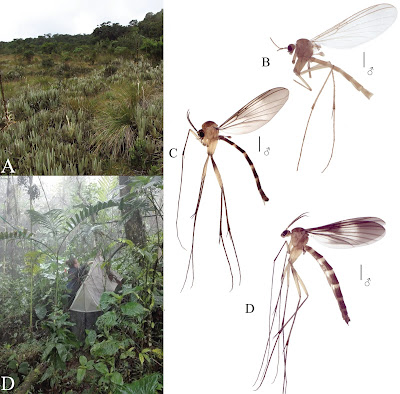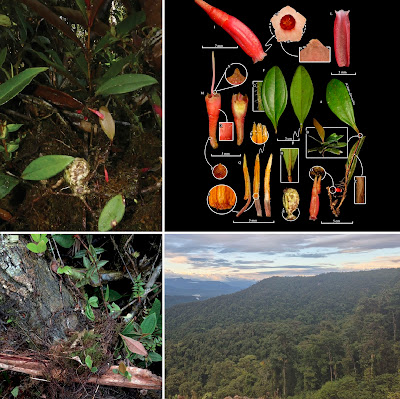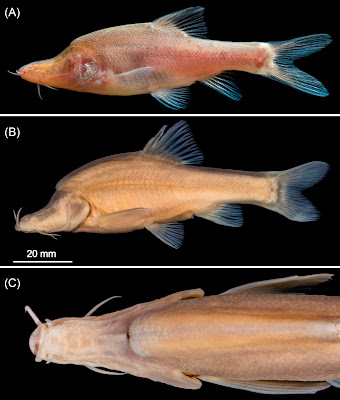[Most Recent Entries] [Calendar View]
Wednesday, July 30th, 2025
| Time | Event | ||||
| 9:13a | [Entomology • 2020] Eudicrana chingaza, E. maculata, ... • Four New Neotropical Species of Eudicrana Loew (Diptera: Mycetophilidae: Sciophilinae) from the Colombian high Andean Ecosystems, with comments on the Genus
Abstract Four new species of the sciophiline genus Eudicrana Loew are described for the Eastern and Central Andes of Colombia–Eudicrana silvaandina sp. nov., E. chingaza sp. nov., E. maculata sp. nov. and E. merizaldei. These are the first species of Eudicrana described from the extreme northern range of the Andes. The altitudinal distribution of these species in the paramos and high Andean forest ecosystems is restricted to 1750–3660 m a.s.l. and some other information on the environment is briefly discussed. A key for the Colombian species of Eudicrana is provided and a discussion is elaborated on the position of these species within the genus. Keywords: Andean ecosystem, biology, diversity, Neotropical region, taxonomy Carolina Henao-Sepúlveda, Marta Wolff and Dalton de Souza Amorim. 2020. Four New Neotropical Species of Eudicrana Loew (Diptera, Mycetophilidae, Sciophilinae) from the Colombian high Andean Ecosystems, with comments on the Genus. ZooKeys. 988: 129-150. DOI: doi.org/10.3897/zookeys.988.49627 | ||||
| 11:12a | [Botany • 2025] Thibaudia shagmiana (Ericaceae: Vaccinieae) • A New Species from the Cordillera del Cóndor in Ecuador
Abstract Background: The neotropical genus Thibaudia Ruiz & Pav. ex J.St.-Hil. (Ericaceae), comprises about 70–75 species and is distributed from Honduras in Central America, through the central Andes south to Bolivia, and eastward to Suriname and Brazil in South America. Ecuador is one of the countries with the greatest diversity of the genus, including 18 species, 12 of which are endemic. Within southeastern Ecuador, the Cordillera del Cóndor is a region characterized by exceptionally high levels of plant endemism, largely due to its unique geology. Recent botanical explorations across this area have led to the discovery of several new species in recent years. Among those was a peculiar species of Thibaudia that is distinct by having exclusively cauliflorous inflorescences in which the pedicel is articulated with the calyx and the filaments are connate. This species is here described and illustrated as Thibaudia shagmiana sp. nov. New information: A new species, Thibaudia shagmiana, is described from the Cordillera del Cóndor in eastern Ecuador. It is distinguished by having a scrambling habit, provided with lignotubers, lanceolate leaves that are verticillate at the apex of branches, solitary and glabrous flowers, caducous bracts and bracteoles, stamens shorter than the corolla, anthers with prognathous thecae, and laterally connate tubules. The taxonomic similarities of the new species are discussed, and information about its distribution, habitat, and conservation is provided. Keywords: Andean Tepui, Neotropics, new species, northern Andes, rainforest, Zamora Chinchipe
Thibaudia shagmiana M.M. Jiménez, Luteyn & Darío García, sp. nov. Diagnosis: Thibaudia shagmiana is distinguished from other members of the genus by its combination of scrambling plant (to 30 cm) and lignotuberous with branches that root from nodes when in contact with mossy litter, lanceolate leaves that are pseudoverticillate at apex of branches, caducous bracteoles, solitary-flowered or 2-fasciculate inflorescences on short rachis, glabrous flowers produced in axils of lower leaves or on leafless branches, cupuliform calyx with a cylindrical limb, corolla with trigonous lobes, stamens ⅔ the corolla length, staminal filaments connate, prognathous thecae, laterally connate tubules, and a style that is shorter than the corolla. Etymology: The new species is named after the Cordillera de Shagmi, a west-facing slope of the Cordillera del Cóndor region in Zamora-Chinchipe province, Ecuador, where this species was found. Marco M. Jiménez, James L. Luteyn, J. R. Kuethe, Darío García, Nadia Lapo-González, Henry X. Garzón-Suárez and Gabriel A. Iturralde. 2025. A New Species of Thibaudia (Ericaceae, Vaccinieae) from the Cordillera del Cóndor in Ecuador. Biodiversity Data Journal. 13: e157044. DOI: doi.org/10.3897/BDJ.13.e157044 | ||||
| 11:12a | [Ichthyology • 2025] Sinocyclocheilus wanlanensis • Description of A New Eyeless Cavefish (Cypriniformes: Cyprinidae) Using Integrative Taxonomic Methods, from Guizhou, China
Simple Summary The karst caves of southwest China are home to an extraordinary diversity of cavefish, especially those in the Sinocyclocheilus group, the largest cavefish genus in the world. Using a combination of morphology and genetic analyses, we describe a new species, Sinocyclocheilus wanlanensis, found in an underground river in Guizhou Province. This fish is eyeless or degenerate-eyed, has no horn-like structures on its head (unlike some of its relatives), and features a large hump behind the head and a snout shaped like a duck’s bill. Measurement and comparison with similar species show that it is distinct morphologically. DNA analysis of two mitochondrial genes places it close to S. bicornutus, a related species; the genetic differences, while small, are consistent with what we observe between known sister species. Sinocyclocheilus wanlanensis is also distinct in appearance: it has degenerated eyes (dark spot) or no eyes (compared to the normal eyes of S. bicornutus); it also lacks the split horn found in S. bicornutus. It can be distinguished from the similar-looking S. zhenfengensis by its eyeless/degenerate-eye condition, shorter facial barbels, and longer pelvic fins. Identifying and describing new species is important for protecting cave life and understanding how species evolve in extreme environments. Abstract China’s southwestern karst landscapes support remarkable cavefish diversity, especially within Sinocyclocheilus, the world’s largest cavefish genus. Using integrative taxonomic methods, we describe Sinocyclocheilus wanlanensis sp. nov., found in a subterranean river in Guizhou Province. This species lacks horn-like cranial structures; its eyes are either reduced to a dark spot or absent. It possesses a pronounced nuchal hump and a forward-protruding, duckbill-shaped head. Morphometric analysis of 28 individuals from six species shows clear separation from related taxa. Nano-CT imaging reveals distinct vertebral and cranial features. Phylogenetic analyses of mitochondrial cytb and ND4 genes place S. wanlanensis within the S. angularis group as sister to S. bicornutus, with p-distances of 1.7% (cytb) and 0.7% (ND4), consistent with sister-species patterns within the genus. Sinocyclocheilus wanlanensis is differentiated from S. bicornutus by its eyeless or degenerate-eye condition and lack of bifurcated horns. It differs from S. zhenfengensis, its morphologically closest species, in having degenerate or absent eyes, shorter maxillary barbels, and pelvic fins that reach the anus. The combination of morphological and molecular evidence supports its recognition as a distinct species. Accurate documentation of such endemic and narrowly distributed taxa is important for conservation and for understanding speciation in cave habitats. Keywords: Sinocyclocheilus; new species; Beipanjiang River; cytochrome b; NADH dehydrogenase subunit 4; integrative taxonomy; cavefish; molecular systematics; mtDNA; China
Sinocyclocheilus wanlanensis Liu, Mao & Yang, sp. nov. Diagnosis. Sinocyclocheilus wanlanensis is distinguished from all its congeners by the following combination of characters: absence of horn-like structure; eyes absent or degenerated into dark spots; a distinct nuchal hump; predorsal profile distinctly arched; the tip of the adpressed rostral barbel extending posteriorly not reaching vertical through the anterior margin of the sunken eye or dark spot; tip of the pelvic-fin rays reaching the anus when pelvic-fin rays extended backward; a distinct head shape protruding forward, resembling a duck’s beak; body scaleless; in life, body light golden brown; lateral line pores 41–45; gill rakers well developed, 9 on first gill arch. Distribution and habitat. Known only from a subterranean river within a cave in the town of Wanlan, Zhenfeng County, Guizhou Province, China. This underground river serves as an important source of drinking and irrigation water for local villagers. They have established large and small pumps to extract water from the cave. The water from this underground river eventually flows into the Beipanjiang River. Sinycyclocheilus wanlanensis occurs in sympatry with several other fish species: Longanalus macrochirous, Pterocryptis anomala, Carassius auratus, and Opsariicthys bidens. Etymology. The new species’ name, wanlanensis, derives from Wanlan Town, Zhenfeng County, where the type specimens were collected. Yewei Liu, Tingru Mao, Hiranya Sudasinghe, Rongjiao Chen, Jian Yang and Madhava Meegaskumbura. 2025. Description of A New Eyeless Cavefish Using Integrative Taxonomic Methods—Sinocyclocheilus wanlanensis (Cypriniformes, Cyprinidae), from Guizhou, China. Animals. 15(15), 2216. DOI: doi.org/10.3390/ani15152216 [28 July 2025] |
| << Previous Day |
2025/07/30 [Calendar] |
Next Day >> |










